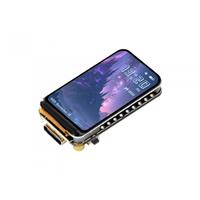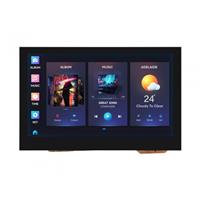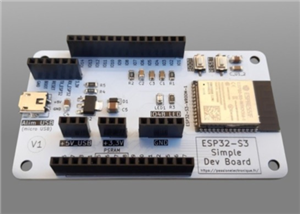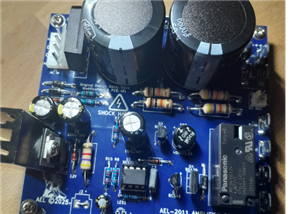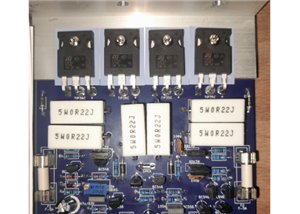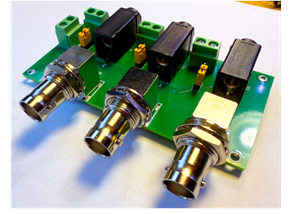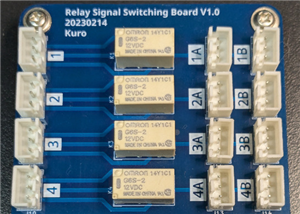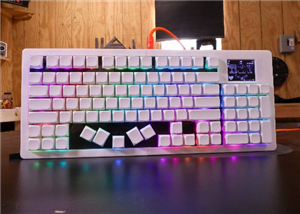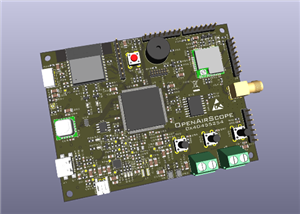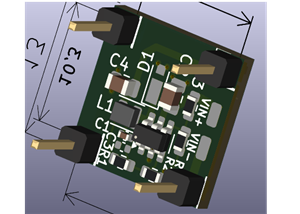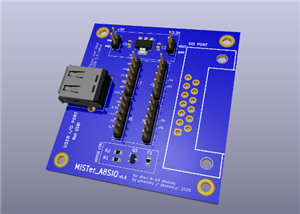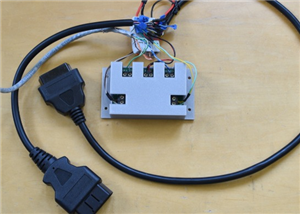Voltage Controlled Audio Oscillator with LM13700s
This is a voltage controlled audio oscillator using two LM13700s.
At 1 KHz ARTA software (http://www.artalabs.hr/) reports THD+Noise of about 0.3%.
I started this about 25 years ago as the backend of a simple Theremin. The front end used two 74HC14 RC oscillators. One was fixed, the other used the capacitance of your hand to change its frequency. The difference in frequencies produced a DC voltage to control the frequency of a VCO using LM13600s (not LM13700s).
Then the LM13600 was discontinued. National Semiconductor said the LM13700 was a suitable replacement. It wasn’t. The LM13600 would work at 9V (a 9V battery) with a resistor divider to produce a bias voltage of 4.5V. The LM13700 does not work at that low a voltage.
This version runs on +12VDC that I regulate down to +9VDC and use an ICL7660 to produce -9V. The reason I took +12V down to +9V is because I want to be able to use the very cheap +12V switching power supplies from China via eBay. Some of these power supplies have 0.5V of hash on the output. Most of them are sold as LED power supplies (LEDs shouldn’t mind the hash) but some are sold as CCTV supplies. I bought two identical supplies (12V 1A) labeled for CCTV. With a load of 120 mA one had 50mV of hash (excellent) but the other had 200mV of hash (crap).
Because the control voltage now starts at -9V I made a level shifter so the input control voltage goes from 0 - 5V.
There is a switch to select the control voltage between an external source and an internal pot. The internal pot can be a trim pot or a real pot. To use a real pot don’t stuff R25 and connect the Real Pot to the R25 pads using wires.
There are three outputs:
1. Line level controlled by R33.
2. Microphone level (fixed).
3. Headphone output controlled by R26. It can also drive an 8 Ohm speaker but not very loudly.
Trim pot R23 controls the bias to the LM13700s. You can adjust it for minimum distortion. But if you go too far the LM13700s will have trouble starting or won’t start at all.
The level shifter trim pot R40 controls the offset. When using the internal control trim pot R31 controls the voltage for the VCO. When using an external control voltage the external voltage source can have a range of 0 - 5V or so.
I used the LM1875 as the headphone driver because it has better specs than the LM386. It is not intended to produce very loud sound in a speaker. If you do use a speaker it should be 8 Ohms or higher. Since many speakers are 4 Ohms you can put two in series. Make sure they are in phase. Otherwise their sound will want to cancel. That assumes the speakers are pointed in the same direction. You could put them in a box with one in the front and one in the back (both pointing outwards). In that case wire them out of phase so the sound will be in phase. I wonder what that would sound like. You could make a speaker enclosure with a speaker on each side. Wire Speaker 1 and Speaker 2 in phase to form Pair 1. Wire Speaker 3 and Speaker 4 in phase to form Pair 2. Wire Pair 1 and Pair 2 out of phase. Orient the speaker enclosure so you are looking at the corner of pair 1. It should produce a nice diffuse sound field. I wonder if anyone has ever tried this. I wonder what it would sound like.
If you are not already a Maker (and you want to be one) see my tutorial on Making Things at www.jmargolin.com/making/jm_making.htm
JM
Voltage Controlled Audio Oscillator with LM13700s
*PCBWay community is a sharing platform. We are not responsible for any design issues and parameter issues (board thickness, surface finish, etc.) you choose.
- Comments(3)
- Likes(5)
-
 Engineer
Mar 19,2025
Engineer
Mar 19,2025
-
 AuDioChosis
Apr 16,2022
AuDioChosis
Apr 16,2022
-
 Ilya
Jun 29,2019
Ilya
Jun 29,2019
-
 IObrizio Fabrizio
May 29,2019
IObrizio Fabrizio
May 29,2019
-
 KHALIL ABD ELKEBIR
May 25,2019
KHALIL ABD ELKEBIR
May 25,2019
- 9 USER VOTES
- YOUR VOTE 0.00 0.00
- 1
- 2
- 3
- 4
- 5
- 6
- 7
- 8
- 9
- 10
- 1
- 2
- 3
- 4
- 5
- 6
- 7
- 8
- 9
- 10
- 1
- 2
- 3
- 4
- 5
- 6
- 7
- 8
- 9
- 10
- 1
- 2
- 3
- 4
- 5
- 6
- 7
- 8
- 9
- 10

-
3design
-
3usability
-
3creativity
-
3content

-
10design
-
8usability
-
8creativity
-
10content

-
7design
-
6usability
-
7creativity
-
7content

-
6design
-
1usability
-
1creativity
-
1content

-
5design
-
5usability
-
5creativity
-
1content

-
8design
-
8usability
-
7creativity
-
7content

-
8design
-
9usability
-
9creativity
-
9content
-
9design
-
9usability
-
9creativity
-
8content

-
10design
-
8usability
-
8creativity
-
7content
 More by Jed Margolin
More by Jed Margolin
-
 MyTX4 To Replace The La Crosse TX4U
My TX4 Wireless Sensor Transmitter replaces the La Crosse TX4U wireless sensor which is no longer ma...
MyTX4 To Replace The La Crosse TX4U
My TX4 Wireless Sensor Transmitter replaces the La Crosse TX4U wireless sensor which is no longer ma...
-
 Audio Tone Burst Generator
The Audio Tone Burst Generator produces a periodic burst of tone at a User-selected audio frequency ...
Audio Tone Burst Generator
The Audio Tone Burst Generator produces a periodic burst of tone at a User-selected audio frequency ...
-
 GPS Clock and Armageddon Alarm 2 and GPS Altimeter
My Raspberry Pi Pico Projects - 2 Jed Margolin 18 January 2025An expan...
GPS Clock and Armageddon Alarm 2 and GPS Altimeter
My Raspberry Pi Pico Projects - 2 Jed Margolin 18 January 2025An expan...
-
 jm_rpi-pico-v6
The Raspberry Pi Pico module is amazing. It is much faster than the Texas Instruments MSP430G2xxx fa...
jm_rpi-pico-v6
The Raspberry Pi Pico module is amazing. It is much faster than the Texas Instruments MSP430G2xxx fa...
-
 Woof Meter
The Woof Meter is for testing subwoofer speakers to measure their Thiele-Small (TS) parameters. Thes...
Woof Meter
The Woof Meter is for testing subwoofer speakers to measure their Thiele-Small (TS) parameters. Thes...
-
 Precision Low Frequency Signal Generator
The Precision Low Frequency Signal Generator produces a User-selected signal from 10Hz to 90Hz with ...
Precision Low Frequency Signal Generator
The Precision Low Frequency Signal Generator produces a User-selected signal from 10Hz to 90Hz with ...
-
 GPS Clock and Armageddon Alarm
A GPS Module using the U-blox NEO6MV2 is used to receive the GPS timing signals to show the exact ti...
GPS Clock and Armageddon Alarm
A GPS Module using the U-blox NEO6MV2 is used to receive the GPS timing signals to show the exact ti...
-
 PB1 - Prototyping Board with Ground Plane and Power Supplies
This board is for prototyping circuits using wire wrap. It has a good ground plane and power supplie...
PB1 - Prototyping Board with Ground Plane and Power Supplies
This board is for prototyping circuits using wire wrap. It has a good ground plane and power supplie...
-
 Flame Switch
This board simulates the electrical characteristic of a flame for troubleshooting residential gas fu...
Flame Switch
This board simulates the electrical characteristic of a flame for troubleshooting residential gas fu...
-
 PB2 - Prototyping Board for MSP430G2xxx
This board is for prototyping circuits with the Texas Instruments MSP430G2xxx microcontroller. It ca...
PB2 - Prototyping Board for MSP430G2xxx
This board is for prototyping circuits with the Texas Instruments MSP430G2xxx microcontroller. It ca...
-
 GP1 - Board for demonstrating how to use an MSP430G2xxx
This board is for demonstrating how to use the Texas Instruments MSP430G2xxx microcontroller. The bo...
GP1 - Board for demonstrating how to use an MSP430G2xxx
This board is for demonstrating how to use the Texas Instruments MSP430G2xxx microcontroller. The bo...
-
 VGA Adapter for Atari Hard Drivin’/Race Drivin’ Cockpit
This VGA Adapter for Atari Hard Drivin’/Race Drivin’ Cockpit also provides for delaying horizontal a...
VGA Adapter for Atari Hard Drivin’/Race Drivin’ Cockpit
This VGA Adapter for Atari Hard Drivin’/Race Drivin’ Cockpit also provides for delaying horizontal a...
-
 Phone Selector/Adapter 2-line to 1-line
This converts an RJ11 line with two phone pairs on it to two single line RJ11 jacks. It provides two...
Phone Selector/Adapter 2-line to 1-line
This converts an RJ11 line with two phone pairs on it to two single line RJ11 jacks. It provides two...
-
 Triangle Wave Generator With Adjustable Symmetry
This is a simple circuit using only one IC, a TL084 quad opamp. The integrator integrates the output...
Triangle Wave Generator With Adjustable Symmetry
This is a simple circuit using only one IC, a TL084 quad opamp. The integrator integrates the output...
-
 Voltage Controlled Audio Oscillator with LM13700s
This is a voltage controlled audio oscillator using two LM13700s. At 1 KHz ARTA software (http://www...
Voltage Controlled Audio Oscillator with LM13700s
This is a voltage controlled audio oscillator using two LM13700s. At 1 KHz ARTA software (http://www...
-
 Oscillator - Xtal or RC
This is an oscillator that can be stuffed to be either a crystal oscillator (with a 74HC04) or an RC...
Oscillator - Xtal or RC
This is an oscillator that can be stuffed to be either a crystal oscillator (with a 74HC04) or an RC...
-
 Sine Wave Generator Using a Johnson Counter
This is a 1KHz audio oscillator using a Johnson Counter. ARTA software (http://www.artalabs.hr/) rep...
Sine Wave Generator Using a Johnson Counter
This is a 1KHz audio oscillator using a Johnson Counter. ARTA software (http://www.artalabs.hr/) rep...
-
 VGA Adapter For Tektronix TDS 360 Oscilloscope
The Tektronix TDS 360 is a two-channel digital oscilloscope from the middle 1990s. The sampling rate...
VGA Adapter For Tektronix TDS 360 Oscilloscope
The Tektronix TDS 360 is a two-channel digital oscilloscope from the middle 1990s. The sampling rate...
-
-
AEL-2011 Power Supply Module
545 0 2 -
AEL-2011 50W Power Amplifier
505 0 2 -
-
-
Custom Mechanical Keyboard
706 0 0 -
Tester for Touch Screen Digitizer without using microcontroller
337 2 2 -
Audio reactive glow LED wristband/bracelet with NFC / RFID-Tags
317 0 1 -
-
-






















